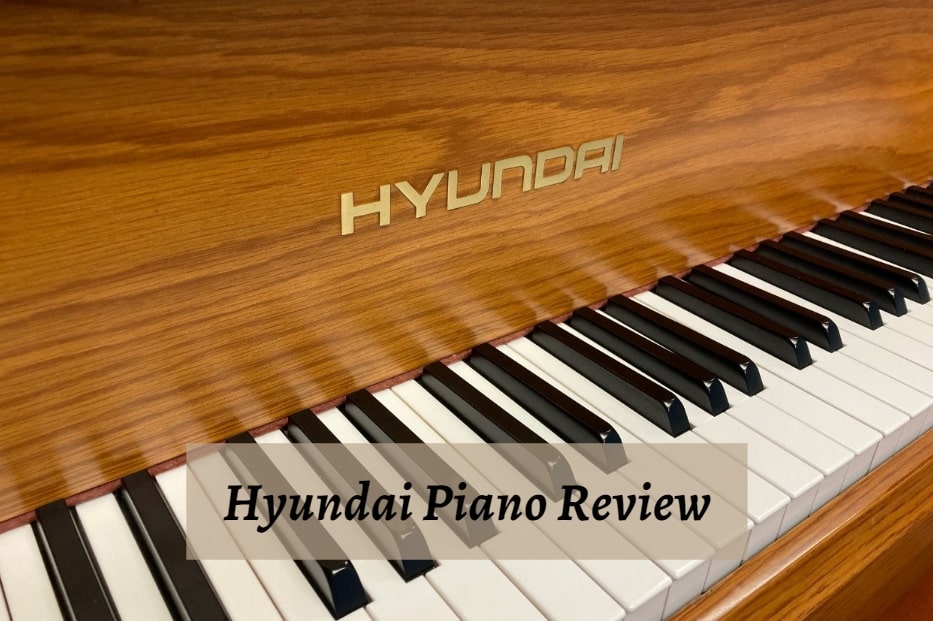
When you hear the name Hyundai, you may think more immediately of cars than of pianos. Hyundai does make both. The South Korean Company Samick manufactures Hyundai pianos and source many of its components from European dealers.
This is not only to ensure the build quality of the instruments but to ensure that the tone of the piano is broadly in line with the expectations of the European market.
Hyundai Piano Review
Samick Music worked with the Hyundai Music Corporation to manufacture the full range of pianos from uprights to grand pianos. This relationship was successfully managed from 1981 to around 1990 when the production of instruments ceased.
Throughout nearly ten years of trading Hyundai sold thousands of pianos, exporting them around the world. For many pianists, they consider the Hyundai pianos to be similar in quality and sound to Young Chang pianos, or low to mid-range Kawai pianos.
Judging from many of the key piano forums available on the internet, the Hyundai pianos were widely accepted as reasonable instruments to buy. Their tonal qualities were characteristically quite bright but with affirmative action.
In terms of manufacturing quality, they appear to be fairly robust and have stood the test of time, given that the last was manufactured over thirty years ago. One issue that has been highlighted is loose tuning pins.
This can lead to the instrument requiring tuning more than is commonly expected, but it is also an issue that is not overly costly to remedy.
With data available on the ‘bluebook of pianos’, the range of upright and grand Hyundai pianos was fairly extensive. At the lower end of the price range were the U-800 models.
They arrived in the showrooms in a pleasant variety of finishes including Ebony, Walnut, and Mahogany. These were high gloss finishes that gave the appearance of a highly professional instrument.
At the other end of the price scale came the 52-inch, U-837. These were selling at around $5600 in comparison to the U-800 at $3500. Apart from the size of these two models, there was not much that distinguished them.
The finishes available were similar and except for possibly better internal components, these were identical units. Some of these instruments remain on the second-hand market across the world and seem to still sell quite well.
As a piano for someone just starting out, they probably make a suitable instrument.
Hyundai grand pianos came in an equally alluring selection of finishes and sizes. These pianos were heralded to be rivals to the likes of the great European manufacturers such as Bechstein and Steinway but this claim may have been a little exaggerated.
The grand pianos spanned sizes from the G-50A at 4′ 7″ right through to the impressive G-85 at 6′ 10″.
In between came grand pianos at 5’1″, 5′ 7″ and 6′ 1″ inclusively. The cheapest of these grand pianos would have been around $9700 with the very top model coming in at $17000.
This top-priced model, the G-85, was quite an impressive instrument according to various internet forums. The finish for this instrument was available in ebony, satin, or high gloss.
These grand pianos still seem to be available as second-hand instruments and do meet the demand for competitive-priced grand pianos.
If these are something you are interested in for yourself, it is recommended that you commission a piano technician to evaluate the instrument before purchase and ensure that any seller offers some kind of guarantee.
As is common with many Asian manufactured pianos, the action can feel light when compared to European models. This may suit your playing style or the type of music that you intend to perform on the instrument, but for many pianists, it is not an attractive feature.
Additionally, you might come across the name ‘Schumann’ on some of these grand pianos. As far as I can tell, these pianos were shipped to the US primarily and remain the same instrument (G-85).
When evaluating the upright range of Hyundai pianos, there are many mixed reviews. On several forums, technicians comment on the poor construction of the instruments with frame angles that cause the bass strings of the instrument to break.
Others remarked on the brittle, metallic tonal qualities of the upright pianos that were not appealing but that these instruments were relatively low-budget options.
The debate seems to continue, especially in the US surrounding the Korean pianos versus the US pianos. There seems to be a consensus that the further back you go in the manufacturing history of Korean pianos, like the Hyundai models, the more likely you are to encounter problems.
Despite these instruments making use of existing German designs and some German components, the overall quality is low.
What appears frequently in articles is the claim that more recent Hyundai pianos are better quality than their American counterparts. They offer a good instrument for the price and have a relatively stable resale value.
They are not overly challenging to find on piano sellers’ sites or shops, which gives some indication of their durability. A general acceptance is that although perhaps earlier models did not meet US and European standards the pianos made and designed today in Korea are world-leading.
The manufacturing techniques have progressively improved to meet the expectations of the worldwide market. This is not an easy challenge to rise to when you are competing with well-established manufacturers whose name alone is often seen as a guarantee of excellence.
Even though Hyundai pianos ceased to be manufactured nearly three decades ago, mostly due to poor profits and weak management, they remain contenders at the less expensive end of the budgetary scale. Perhaps as a starter piano, the Hyundai represents an acceptable instrument.
Certainly at the high end of the list, one of the Hyundai grand pianos could offer a very competitively priced piano second-hand instrument.
All of these older instruments are probably in need of being professionally set up and if you like the action and the sonority, you have a piano to enjoy.

I lived in a house with a ruby red Kawai piano , the sound was like the smell of roses .